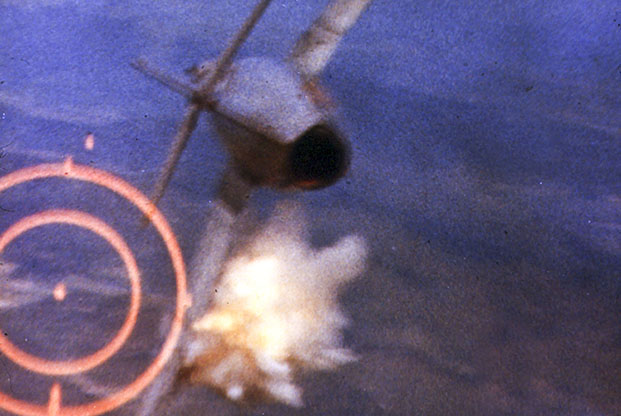A North Vietnamese MiG-17 is hit by 20 mm rounds from an Air Force F-105D on June 3, 1967. Photo: USAF via National Archives
In the beginning, the North Vietnamese air force was a rag-tag operation with obsolete, cast-off equipment. The first unit was formed in 1959. The first combat aircraft was a T-28 trainer whose pilot defected from the Laotian air force.
The Vietnamese Peoples’ Air Force—as it was officially called—sent pilots to the Soviet Union and China for training in MiG fighters but had no jet aircraft of its own until February 1964, when the Soviets donated 36 MiG-15s and -17s to the VPAF.
For reasons of security, the MiGs were based across the border in southern China and did not deploy to Phuc Yen Air Base near Hanoi until August 1964, after the buildup of US forces in Southeast Asia following an attack on US ships in the Tonkin Gulf.
The VPAF would not gain its first MiG-21s until November 1965, and the MiG-15s and -17s were not regarded as any real threat to late-model US fighters. Thus, it came as a surprise on April 3, 1965, when a pair of MiG-17s pounced on a US Navy strike flight south of Hanoi and raked the F-8E Crusader fighter-bombers with 23 mm cannon fire.
The North Vietnamese believed, erroneously, that they had destroyed two of the Crusaders. In fact, they inflicted significant damage on only one of them. However, they had better luck the next day.
On April 4, in the first confirmed aerial victories for either side, MiG-17s shot down two US Air Force F-105s that were attacking the “Dragon’s Jaw” bridge at Thanh Hoa. The MiGs came in through a thick layer of haze, eluding the F-100s flying protective air patrol. The Thuds, carrying heavy bomb loads, were unable to react.
The first US victories were in June 1965 by Navy F-4Bs operating from a carrier in the Tonkin Gulf. The first Air Force victories did not occur until July 10, when F-4Cs, flying from Ubon Air Base in Thailand, shot down two MiG-17s.
USAF and USN fighters confronted the MiGs in two phases: 1965-1968 and 1972-1973, separated by an interval when operations over North Vietnam were halted during negotiations attempting to end the war.
US pilots and aircraft were clearly superior, and they had an overwhelming advantage in numbers. Even so, the small, quick-turning MiGs proved to be formidable opponents. American airmen shot down 196 MiGs—137 by the Air Force, 59 by the Navy and the Marine Corps—and sustained 83 losses.
In historical context, it was a far cry from World War II, when the Army Air Forces awarded more than 15,000 aerial victory credits, or the Korean War, in which Air Force F-86s shot down 792 MiG-15s and achieved an exchange ratio of better than 10-to-1.
Vietnam was a different kind of war.
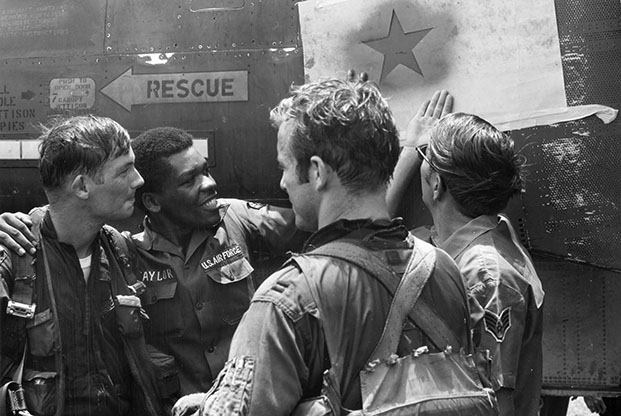 An F-4 crew admires a fifth aerial kill marked on their F-4 Phantom. L-r: Capt. Charles DeBellavue, Sgt. Reggie Taylor, Capt. Richard Ritchie, and SSgt. Frank Falcone. Photo: A1C Larry Groom
An F-4 crew admires a fifth aerial kill marked on their F-4 Phantom. L-r: Capt. Charles DeBellavue, Sgt. Reggie Taylor, Capt. Richard Ritchie, and SSgt. Frank Falcone. Photo: A1C Larry Groom
LIMITED OBJECTIVES
“Winning the air war” in a classic sense was not the strategy followed by either side. Destruction of enemy aircraft was, for both, a secondary objective.
The purpose of US fighters engaging the MiGs was to protect the strike flights. “MiG killing was not our objective,” said Maj. Gen. Alton D. Slay, deputy chief of staff for operations at 7th Air Force. “The objective was to protect the strike force. Any MiG kills obtained were considered a bonus. A shootdown of a strike aircraft was considered a mission failure, regardless of the number of MiGs killed.”
For their part, the North Vietnamese employed MiGs specifically to stop the strike flights. They avoided combat when risk was high. “The principal MiG mission was to interfere with bombing attacks, seeking to force the incoming F-4s and F-105s to jettison their bombs before getting on target, a strategy that took full advantage of the encumbrance of US rules of engagement and prevented the F-4s from mixing it up with the MiGs,” said Air Force historian Walter J. Boyne.
In any case, the air campaign in North Vietnam was of limited interest to officials in Washington. Although the war was instigated, directed, supplied, reinforced, and sustained from the North, US policy was that the outcome would be decided in the south.
By order of Defense Secretary Robert S. McNamara, the only military goal of the air campaign was “to reduce the flow and/or increase the cost of infiltration of men and supplies from North Vietnam to South Vietnam.” Confrontation with MiGs was incidental to that.
The North Vietnamese gained extra advantages from the sanctuaries and rules of engagement created by US policy.
Attacks were forbidden in large prohibited areas around Hanoi and Haiphong. The principal MiG base at Phuc Yen was not struck until 1967, and Gia Lam was never struck. US airmen could watch MiGs come out, taxi to the end of the runway, and run up their engines for takeoff, but could not touch them until they actually took off. The MiGs could also escape over the border into China.
Visual identification of enemy aircraft was required rather than using radar for target acquisition and firing long-range missiles before the MiGs could attack. “We forfeited our initial advantage of being able to detect a MiG at 30- to 35-mile range,” said Gen. William W. Momyer, commander of 7th Air Force from 1966 to 1968.
An Air Force report from the period noted that “on several occasions US fighters found that by the time visual identification of the MiG had been made they were no longer in the prescribed missile launch or range envelopes. The engagement then became a short-range maneuvering encounter, which further compounded the problem of accurate missile launch.”
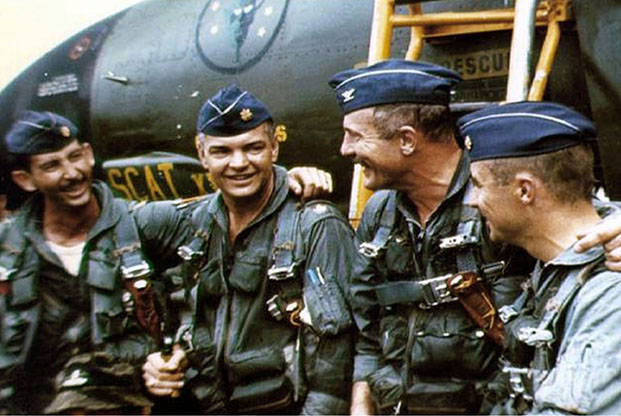
Col. Robin Olds (third from left) celebrates completing the famous MiG sweep, Operation Bolo, with airmen at Ubon AB, Thailand. Photo: USAF
MATCHUP
The principal matchup was between the McDonnell Douglas F-4 Phantom II—flown by the Air Force, the Navy, and the Marine Corps for bombing, combat air patrol, reconnaissance, and suppression of enemy air defenses—and North Vietnam’s MiG-17s and MiG-21s.
The F-4 was developed by the Navy and entered service in 1962. It had impressive speed, range, and versatility, and it remained the leading US fighter into the 1970s. The original Phantom was modified and employed in Vietnam as the Air Force F-4C and F-4D and the Navy F-4B and F-4J. The ultimate USAF model was the F-4E, introduced in 1968 and adding a 20 mm cannon to the existing armament of air-to-air missiles.
The single-engine MiGs were half the size of the F-4 and more agile. The MiG-17, an advanced version of the Korean War MiG-15, was no longer top of the line, but it performed well as an interceptor. The MiG-21 was North Vietnam’s best fighter and a close match in capability with the F-4.
The older MiG-15s were used only for training purposes. The MiG-19, manufactured in China, did not appear until the last part of the war. It was less maneuverable than the MiG-17 and slower than the MiG-21.
The North Vietnamese offset their vulnerabilities by picking their times to fight. “MiG pilots only attacked under ideal circumstances, such as when USAF aircraft were bomb-laden, low on fuel, or damaged,” an Air Force statement said. “The small, hard-to-see MiGs typically made one-pass attacks at high speed, then escaped to a sanctuary.”
When the engagement was straight forward, the MiGs seldom won. The trick was inducing them to engage at all, if the F-4s were ready and configured to fight.
In Operation Bolo, the famous “MiG Sweep” of January 1967, a force of F-4Cs from Ubon entered North Vietnam pretending to be bomb-carrying F-105s. They followed Thud ingress routes, and their radio calls simulated Thuds. The MiG-21s at Phuc Yen were deceived and rose up to meet them. In a swirling 15-minute dogfight, the Phantoms shot down seven MiG 21s—almost half of the total possessed by North Vietnam—with no loss of F-4s.
The F-4s did not account for all of the MiGs destroyed, though. The older F-105 had been designed primarily for high-speed, low-altitude nuclear delivery missions. Momyer rated it “a very poor plane in a dogfight,” but it managed to bring down more than two dozen MiGs. The Navy’s single engine F-8 Crusader bagged 15 MiGs.
The most surprising victories were by Navy propeller-driven A-1H Skyraiders, which shot down two MiG-17s with their 20 mm cannons.
MiGs were the most flexible and versatile part of the most lethal air defense system US aircraft had ever faced—but the MiGs were not the greatest threat. USAF combat losses in Vietnam were distributed as 67 to MiGs, 110 to surface-to-air missiles, and 1,443 to antiaircraft artillery.
The combination of MiGs, SAMs and guns was so effective that in 1966, the USAF loss rate in Route Pack Six, around Hanoi and Haiphong, was one aircraft per 40 sorties. This made the odds very tough for aircrews, who had to fly 100 missions to complete a full combat tour.
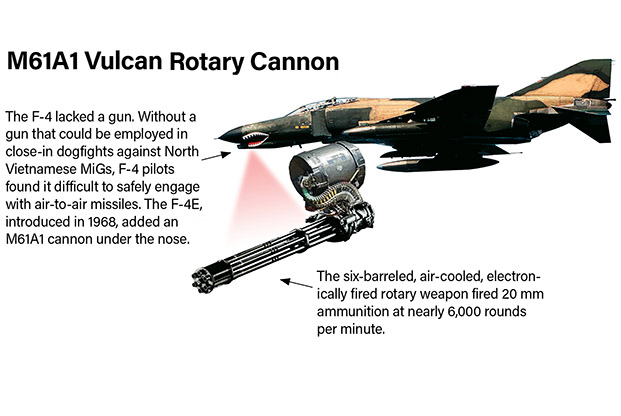 Photo: USAF; Graphic: Mike Tsukamoto/staff
Photo: USAF; Graphic: Mike Tsukamoto/staff
GUNS AND MISSILES
When the F-4 was designed and developed in the 1950s, US planners believed the era of the dogfighter was over. “Fighter design priorities emphasized the nuclear delivery and interceptor missions,” Jim Cunningham said in an analysis for Air & Space Power Journal. “The underlying assumption was that nuclear weapons would make conventional wars obsolete and that as a result, air combat maneuvering (ACM) was dead, overtaken by the interception mission, which required supersonic speed, high technology sensors, and missile weaponry.”
The F-105 packed a fast-shooting 20 mm cannon, but early models of the F-4 did not have a gun. This was a disadvantage in the subsonic, turning battles with MiGs where it was often awkward to employ missiles.
In 1967, a gun pod mounted on a pylon was provided for the F-4D but the problem was not completely resolved until the first F-4Es with built-in guns arrived in Southeast Asia in November 1968, just as the bombing halt over North Vietnam went into effect. After operations in the North resumed in 1972, half of the USAF victories were achieved by guns.
Navy airmen also complained about the lack of a gun, but a cannon in the nose shifted the F-4’s center of gravity too far forward for carrier operations, so USN aircrews finished the war with their missile armament.
The main US air-to-air missiles were the radar-guided AIM-7 Sparrow and the heat-seeking AIM-9 Sidewinder. Sparrow had an effective range of more than 10 miles, compared to about two miles for Sidewinder.
Overall, Momyer said, “most of our kills were made with missiles, and in fact, 57.5 percent were made with Sparrows. Navy fighters, on the other hand, made almost all of their kills with the Sidewinder.”
The Navy kills, Momyer said, “were predominately MiG-17s and they were made in close-in engagements. Such engagements required more frequent employment of short range weapons, and since the Navy F-4s had no guns, the Sidewinder missile was their primary weapon.”
As for the VPAF, the MiG-17 was basically a gun platform. The MiG-21s had guns but relied mainly on their Atoll heat-seeking missiles.
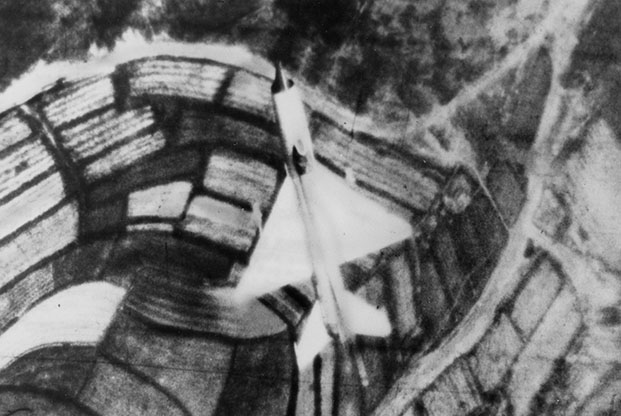
The image of a North Vietnamese MiG-21 as viewed through the lens of a USAF gun camera during a dogfight. Photo: USAF
AGAINST THE MIGS
Despite the success of the Bolo operation, the Air Force did not conduct any more fighter sweeps. “There weren’t enough fighters available to conduct random fighter sweeps and also protect the strike force during their specified times in the target area,” Momyer said. “Even if fighters could have been spared for daily sweeps, the shortage of tankers would have precluded such a tactic.”
“US Air Force coverage ranged from spotty to nonexistent over assigned strike routes,” said military analyst William Sayers, writing in Vietnam Magazine. “Fighters escorting the bomb-carrying aircraft never knew where the threat would come from and therefore normally stayed close to the planes they were protecting so they wouldn’t be caught out of position during an attack. As a result, US Air Force aircraft usually entered engagements from a defensive and reactive posture.”
“After action reports found that 65 percent of Air Force losses were suffered by aircraft fighting from a defensive posture, which required a fighter under attack to reverse positions to get a kill, a very difficult maneuver to make,” Sayers said.
The North Vietnamese air defense system had more than 200 radar facilities that provided warning and guidance for the MiGs, SAMs, and guns.
“The MiG-21s were operated under tight ground control,” said historian Boyne. “They typically sought to stalk American formations from the rear, firing a missile and then disengaging.”
At one point in 1967, Momyer believed that the MiG threat had been neutralized. The North Vietnamese fighter fleet stood at 40, of which only 12 were MiG-21s. However, the losses were soon replenished by the Soviets and the Chinese. When the air war resumed in 1972 after the bombing halt, the VPAF MiG total was up to 206, an all-time high.
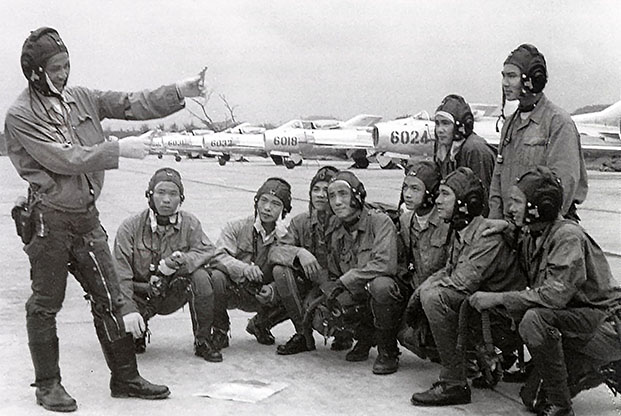
North Vietnamese pilots are briefed on dogfighting tactics in front of Chinese-made MiG-19s. These aircraft arrived late in the war, were less maneuverable than the MiG-17, and slower than the MiG-21. Photo: Vietnamese News Agency
TEABALL
In the final count of aerial combat credits and losses, US fighters in battle with the MiGs achieved an exchange ratio of 2.36-to-1. More than two-thirds of the MiG kills were by the Air Force, but the USAF exchange ratio of 2.04 was not as good as the Navy’s 3.68.
Several factors contributed to the difference. Navy airmen, flying off carriers in the Tonkin Gulf, entered Vietnam with their backs to the sea and the MiG threat in front of them. This limited the opportunity for the MiGs to use their favorite tactic of surprise attacks from the rear.
Whereas the large majority of Air Force encounters were with MiG-21s, about half of the Navy engagements were against MiG-17s and -19s. Furthermore, many of the Navy targets were near the coast and did not require extensive time to be spent in enemy territory.
Without doubt, naval aviators also got a performance boost from the Top Gun combat training introduced in 1969 by the Navy Fighter Weapons School. The Air Force did not have anything comparable until its Red Flag program began in 1975.
The biggest advantage for Navy F-4s, though, was probably Red Crown, a picket ship stationed a few miles offshore that provided radar coverage and warning of MiG activity. Its signal reached into the Red River delta as far as the airfields around Hanoi and directed intercepts of the MiGs. A number of Air Force aircrews credited Red Crown with vital assistance to them as well.
Air Force results against the MiGs improved markedly in the last six months of US involvement in Vietnam. In 1972, a fusion center to pull together intelligence information from all reconnaissance sources was established at Nakhon Phanom air base in Thailand with the call sign “Teaball.”
Teaball screened, combined, and analyzed a large volume of data in order to provide the earliest possible MiG warning to the strike forces. Controllers notified aircrews not only of the location of a MiG, but also whether it was a MiG-17, -19, or -21. Having tracked the aircraft from time of takeoff, Teaball could determine when they were low on fuel.
Gen. John W. Vogt Jr., commander of 7th Air Force from 1972-1973 described Teaball as “by far the most effective instrument in the battle with the MiGs.” Some disagreed with that assessment, regarding Red Crown and other intelligence sources as more important.
As historian Wayne Thompson has noted, though, there was an “obvious correlation” between the beginning of Teaball operations in August 1972 and 7th Air Force’s “dramatically improved performance against MiGs. During the next three months, the score was 20 MiGs down at a cost of only four F-4s,” raising the exchange ratio to 5-to-1 in the USAF’s favor.
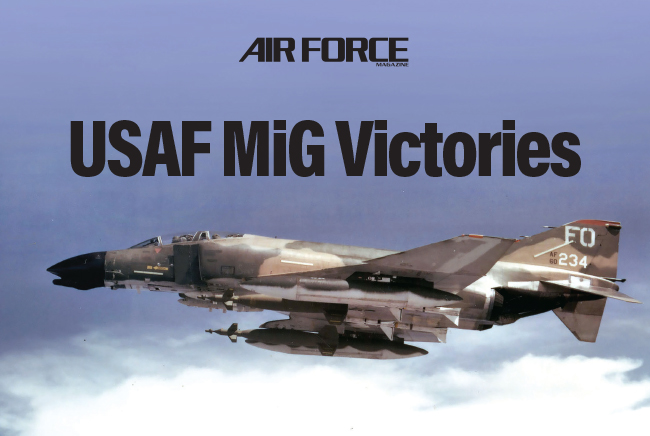 Click here or on the image above to view Air Force Magazine’s full-size infographic as a PDF. Photo: USAF; Teaser Graphic: Dashton Parham/staff
Click here or on the image above to view Air Force Magazine’s full-size infographic as a PDF. Photo: USAF; Teaser Graphic: Dashton Parham/staff
ACES
In World War II, hundreds of US airmen became aces, credited with five or more aerial victories. By contrast, the Vietnam War produced only five aces, three from the Air Force and two from the Navy.
The leading US ace in Vietnam was Air Force Capt. Charles B. DeBellevue with six victory credits. He was a navigator, flying as a weapons system officer, in the back seat of the F-4. Air Force and Navy officers assigned to the back seat of the Phantom were not required to be pilots, and full credit for a MiG was awarded to the airmen in both seats.
Only two of the Vietnam War aces—Air Force Capt. Richard S. “Steve” Ritchie and Navy Lt. Randall H. Cunningham—were pilots. Air Force Capt. Jeffrey S. Feinstein was, like DeBellevue, a WSO. Navy Lt. William Driscoll was a naval flight officer flying as a radar intercept officer. Except for DeBellevue, the US aces had five MIG credits each.
North Vietnam recognized 16 VPAF aces. The leader was Nguyen Van Coc, with nine credits awarded, seven of them for US aircraft and two for Firebee drones. In accumulating his credits, he flew combat missions from 1967 to 1969.
Thirteen of the North Vietnamese aces flew the MiG-21 and three flew the MiG-17. There were no MiG-19 aces.
One of the enduring legends of the war was “Colonel Toon,” supposedly the greatest of all North Vietnam’s MiG pilots with 13 small red victory stars on the fuselage of his airplane, signifying US fighters shot down. The legend was embellished with the supposition that on May 10, 1972, Randy Cunningham—on the mission in which he became an ace—shot down Colonel Toon. William Driscoll was in the back seat that day.
In reality, Colonel Toon never existed. The stars on the fuselage, if they were there at all, were the collective credits by a number of pilots flying that airplane. The imagined Colonel Toon was traced in part to confusion by signals intelligence operators listening to North Vietnamese radio communications.
In broad context, the US fighters in Vietnam succeeded in their air-to-air objectives, and the MiGs did not. From beginning to end—from Operation Rolling Thunder early in the war to Linebacker in the finale—the strike forces got through to their targets. The MiGs, try as they might and despite occasional periods of success—could not stop them.
John T. Correll was editor in chief of Air Force Magazine for 18 years and is a frequent contributor. His most recent article, “From Out of the Shadows,” appeared in the September issue.
